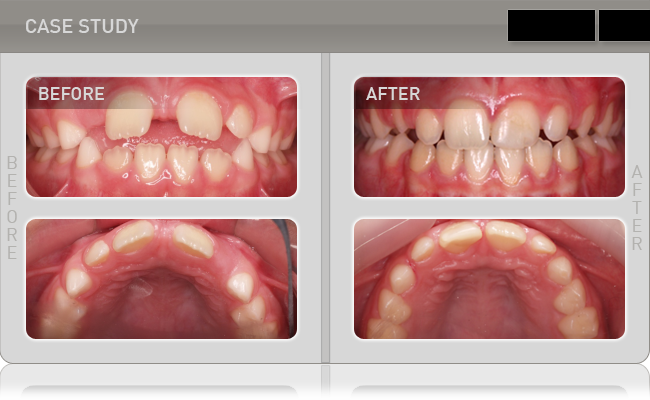
Case Study (Mixed Dentition)
This 7 year old girl had severe spacing and an extreme openbite. Her parents obviously had concerns and did not want to wait for treatment. The 'After' shot (above, right) shows the patient at age 10. This result was achieved before the patient was at an age when traditional orthodontic treatment with braces and/or extractions is generally suggested. Treatment was completed with Trainer™ and Myobrace® system appliances only.
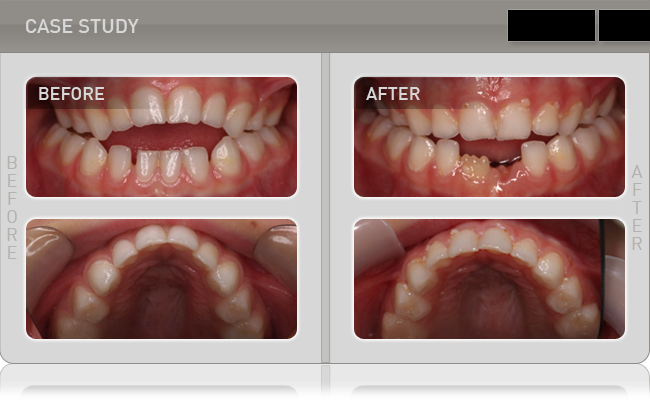
Case Study (Primary / Early Mixed Dentition)
This child presented at 5 years of age in the late-primary dentition with a severe openbite and a very narrow maxilla. Note the 'V' shape anterior arch-form. The patient was treated with the Infant Trainer™ followed by the T4K®.
The openbite was closed prior to the permanent anterior dentition erupting, making further orthodontic treatment less complex. Note the improved upper arch-form produced by correcting the child's tongue-thrust habit and resting tongue position.
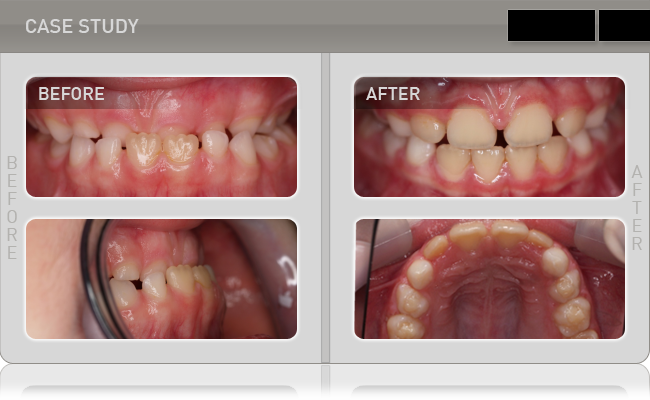
Case Study (Primary / Early Mixed Dentition)
This patient presented in the clinic at age 6 with a Class III malocclusion. The parents had previously been informed that the only option was surgery when growth has stopped.
Treatment involved use of the T4K® followed i-3®, combined with the use of Myolay™ inclined planes to re-posture the mandible combined with myofunctional habit correction.
The results show complete anterior crossbite correction with no need for future surgery.
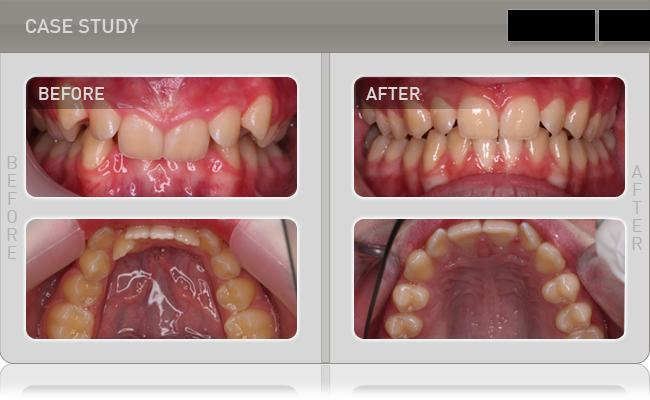
Case Study (Late Mixed / Permanent Dentition)
This case is an extreme Class II Division 2 malocclusion in the early-permanent dentition. The case shows blocked out canines in the upper and lower arches with severe deepbite. This would generally be considered a possible extraction case due the the patient's age and the severity of the malocclusion. The case was treated without braces and without extractions using the combination of BWS™ + K1, followed by a K2, then finalised with a T3 and T4. This has allowed forward development of the maxilla and obtained space for the lower canines and de-crowd the lower anterior teeth. Further alignment of the upper anterior teeth could be obtained using fixed appliances for 3-6 months, however, the patient was satisfied with the alignment.
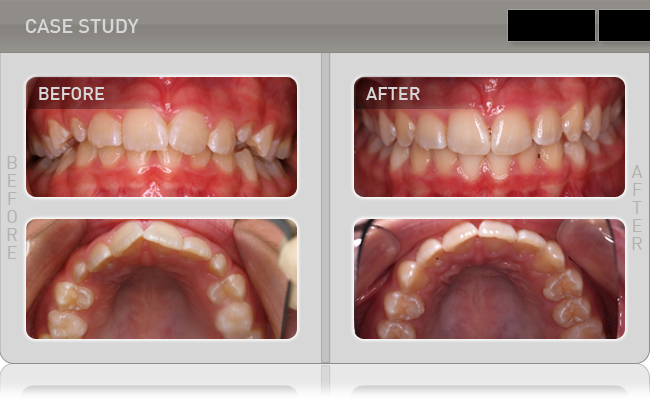
Case Study (Late Mixed / Permanent Dentition)
This case presented with mild crowding at the age of 11 in the late-mixed dentition stage.
You will note the 'V-shaped' arch-form and the midline shift which is typical of lowered anterior tongue position from mouth breathing. Treatment used the BWS™ + K1 followed by the T2, T3 and T4. No braces and no retainers were required.
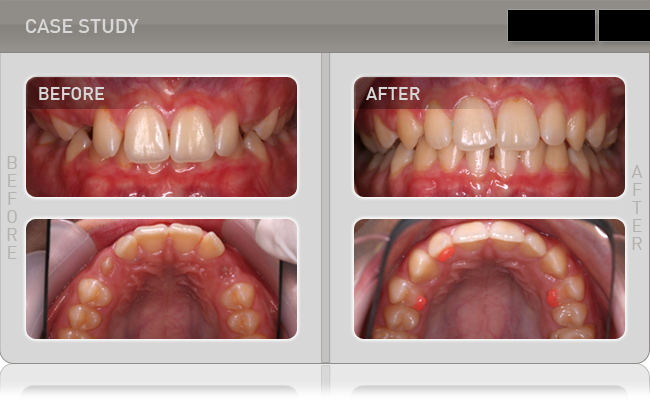
Case Study (Late Mixed / Permanent Dentition)
This case was a 12 year old boy with severe deepbite and a narrowed maxilla in the late-mixed dentition stage. The child was a mouth breather which typically causes this type of malocclusion. Treatment used the BWS™ + K1 followed by the K2, T3 and T4. Note the dramatic improvement in the deepbite without any mechanics being used to open the vertical dimension. The improved upper arch-form and the deepbite improvement are primarily as a result of the Myobrace® correcting the mode of breathing and tongue position. Note the red composite is used to maintain the position of the BWS™ and is removed at the end of treatment.
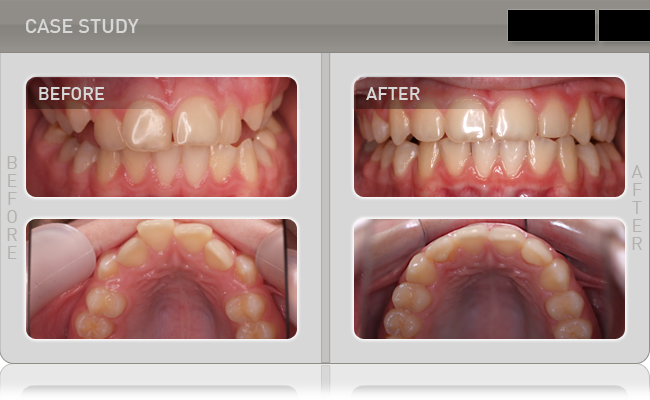
Case Study (Late Mixed / Permanent Dentition)
A child in the early-permanent dentition showing mild crowding in the upper arch and incorrectly erupting canines. Note that the child is a mouth breather which is the primary cause of the underdevelopment of the maxilla.
Treatment was commenced using the BWS™ + K1, followed by the K2, T3 and T4. Note the improvement in the arch form which is an effect of correcting mouth breathing and tongue position - one of the primary effects of the Myobrace system.
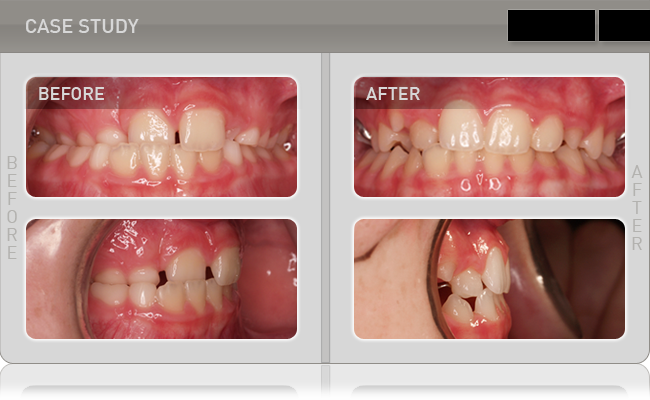
Case Study (Mixed Dentition)
This 9 year old patient had a severe crossbite and space loss resulting in a lack of space for the erupting lateral incisor and canine.
Treatment involved use of the Biobloc Stage 1 to correct the crossbite, followed by the BWS™ + K1 for further arch development and myofunctional correction. Note that this early interceptive treatment has resulted in obtaining sufficient space for the erupting teeth plus a stable Class I bite with a midline correction.
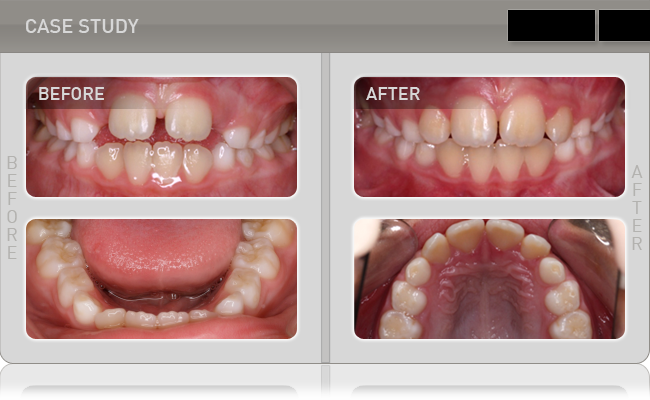
Case Study (Mixed Dentition)
This case is in the early-mixed dentition with an open bite and the resulting malocclusion. This is primarily due to a thumb sucking and subsequent tongue thrusting habit.
Treatment involved the use of the T4K® and considerable patient education to assist in the correction of the thumb sucking, tongue thrusting habits. This was followed by the K2 which was used for further arch development. Note the closing of the upper anterior spaces and the improvement in the lower anterior alignment. This is the effect of the myofunctional habit correction which is a product of the Myobrace System™.
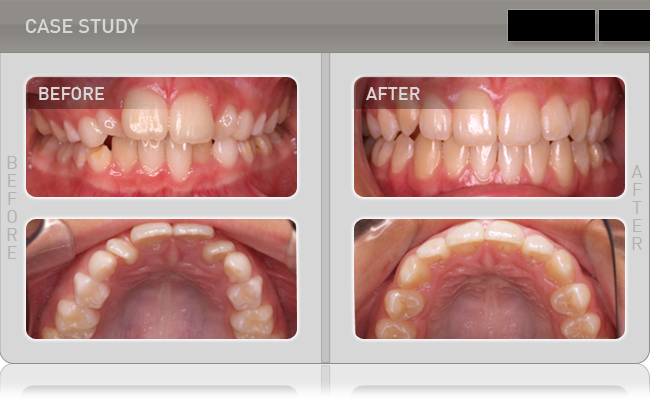
Case Study (Mixed Dentition)
This patient presented in the early-mixed dentition with severe crowding of the upper and lower anterior teeth. The parents were told that extractions and braces would potentially be required and so decided to seek early interceptive treatment to possibly avoid this option. The crowding is typical of a child with a mouth breathing and reverse swallowing habit. These habit need to be corrected as a priority as soon as they are detected.
Treatment involved BWS™ + T4K®, followed by K2, T3 and T4. Final minor adjustments were achieved with clear aligners. Note the improvement in the upper arch-form and the almost perfect alignment of the upper lateral incisors without the requirement for fixed appliances or extractions.
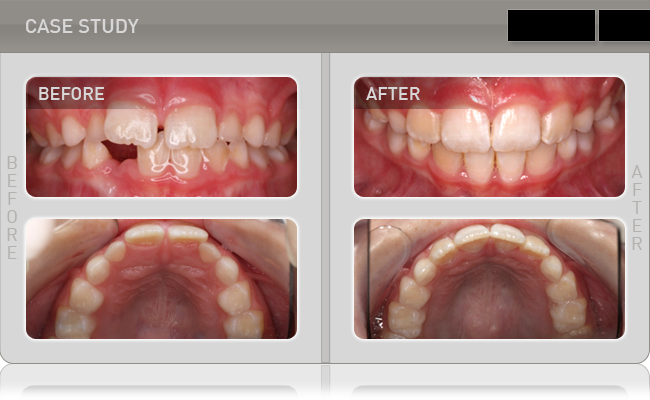
Case Study (Mixed Dentition)
This patient presented in the clinic in the early-mixed dentition showing spacing, which is typical of an anterior tongue thrust. Treatment used the T4K®, followed by the K2. Note the arch-form improvement through the correction of tongue position and function. Furthermore, the spacing has been closed by the use of the Myobrace K2 and myofunctional habit correction.
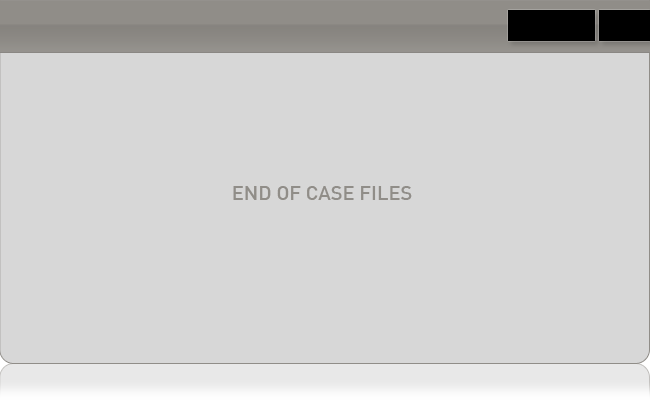
End of Case Files
More detailed case studies can also be found in the 'Appliance' section of this website.